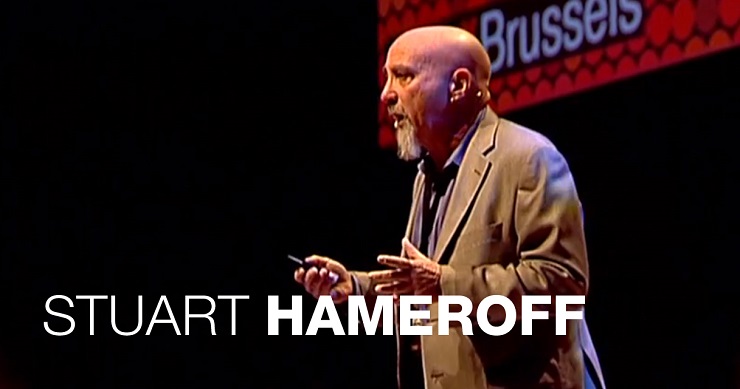Exploring the Quantum Soul | Bridging Consciousness and Quantum Biology | Unraveling the Mystery of Microtubules, Consciousness, and the Future of Humanity
 Stuart Hameroff’s provocative ideas on a “quantum soul” challenge the long-held assumptions of conventional neuroscience and materialism. In his TEDx Brussels 2010 talk, Hameroff argues that consciousness is not merely an epiphenomenal byproduct of neural networks but rather an emergent property deeply intertwined with quantum mechanics. This post explores his perspectives alongside the broader scientific and philosophical implications of a universe where quantum processes might underpin our very awareness.
Stuart Hameroff’s provocative ideas on a “quantum soul” challenge the long-held assumptions of conventional neuroscience and materialism. In his TEDx Brussels 2010 talk, Hameroff argues that consciousness is not merely an epiphenomenal byproduct of neural networks but rather an emergent property deeply intertwined with quantum mechanics. This post explores his perspectives alongside the broader scientific and philosophical implications of a universe where quantum processes might underpin our very awareness.
Hameroff’s work, as discussed in the SpeciesUniverse.com article and his TEDx talk, pushes the boundaries of how we traditionally view the brain’s operations. Instead of focusing solely on neurons and classical electrical signals, he directs our attention to microtubules—tiny, cylindrical structures within our neurons. According to his research, these microtubules may serve as quantum processors that allow the brain to perform computations at a level that classical models simply cannot explain. This paradigm shift invites us to reconsider what it means to be conscious in a universe where the observer effect is not just an abstract concept but a tangible force influencing our reality.
At the heart of Hameroff’s theory is the Orch OR (Orchestrated Objective Reduction) model, developed in collaboration with Sir Roger Penrose. This theory posits that quantum computations within microtubules lead to moments of objective reduction—a collapse of quantum states that generates conscious experience. Despite criticisms from proponents of classical materialism, Hameroff and Penrose provide a compelling narrative that links the ephemeral qualities of quantum mechanics with the richness of human consciousness, hinting that our inner experiences might indeed be deeply connected to the fabric of spacetime.
The transcript of his TEDx presentation vividly illustrates the intersection of quantum physics and biology. Hameroff describes the quantum realm as “immaterial, coexisting possibilities, non-local, unified, connected” in contrast to the “billiard-ball universe” of classical physics. He argues that such quantum features are not only present but may be essential in biological systems—from the efficiency of photosynthesis to the mechanisms underlying memory and cognition. This presentation offers a fresh perspective on the “quantum soul,” suggesting that our subjective experiences could emerge from quantum processes operating at scales beyond our immediate perception.
Supplementary research in the field of quantum biology supports many of Hameroff’s assertions. Studies have shown that quantum coherence—the property that allows particles to exist in multiple states simultaneously—plays a crucial role in processes like photosynthesis, where plants convert sunlight into energy with remarkable efficiency. Furthermore, recent investigations into quantum effects in warm, wet biological systems have begun to challenge the long-held belief that such coherence could only occur in isolated, cryogenic environments. These findings add weight to the idea that quantum phenomena might not only be viable in the brain but could be central to life itself.
Beyond the theoretical, the practical implications of a quantum approach to consciousness are profound. If quantum mechanisms are indeed at work within our neurons, then our understanding of mental health, memory disorders, and even neurodegenerative diseases could be transformed. Hameroff’s exploration into how microtubules interact with quantum fields opens up potential therapeutic avenues—for instance, interventions that might restore or enhance quantum coherence in the brain could revolutionize treatments for conditions such as Alzheimer’s disease. Moreover, the prospect of interfacing with this quantum code offers tantalizing possibilities for future technologies, including the potential for consciousness to be uploaded or teleported to alternative media.
In conclusion, the debate over a quantum soul is more than an academic exercise—it is a call to rethink the nature of existence itself. While materialists may resist this paradigm shift, the emerging evidence from quantum biology, coupled with Hameroff’s visionary insights, presents a compelling argument for embracing a broader understanding of consciousness. As we continue to explore these frontiers, we are invited to question the limitations of classical thought and consider the vast, untapped potential that lies in the quantum fabric of the universe. John, and all curious seekers, this exploration beckons us to open our minds and venture into realms where science and spirituality converge.
Key Takeaways:
- Quantum Complexity: The brain’s microtubules may operate as quantum processors, challenging traditional views of consciousness.
- Orchestrated Reduction: The Orch OR theory connects quantum mechanics with the emergence of consciousness, suggesting that our inner life is interwoven with the fabric of spacetime.
- Bridging Disciplines: Embracing quantum biology could revolutionize medicine and technology, offering new ways to understand and harness the power of the mind.
“Quantum biology is literally the secret of life, and its understanding may save the world.”
Join us on SpeciesUniverse.com to further explore these groundbreaking ideas and discover how embracing the quantum nature of life can transform our understanding of consciousness and the universe. Engage with the community, share your thoughts, and help us chart the course to a deeper, more connected future.
Questions for you?
- Do you think Quantum Mechanical effects occur in biology?
- Do you think Dr. Stuart Hameroff is heading on the right direction with microtubules and Orch OR?
Please let me know what you think in the comment area below.
And thank you for visiting Species Universe.
Relevant Content:
- Stuart Hameroff – Does Consciousness Cause the Cosmos?
- Could Quantum Brain Effects Explain Consciousness? – LiveScience.com
- Discovery of quantum vibrations in ‘microtubules’ inside brain neurons supports controversial theory of consciousness – Science Daily
- Stuart Hameroff and Jonathan Powell: The Conscious Connection
- CONSCIOUSNESS: A conversation with Deepak Chopra and Stuart Hameroff
- “Consciousness and Microtubules” by Dr. Stuart Hameroff
References:

Leave a Reply